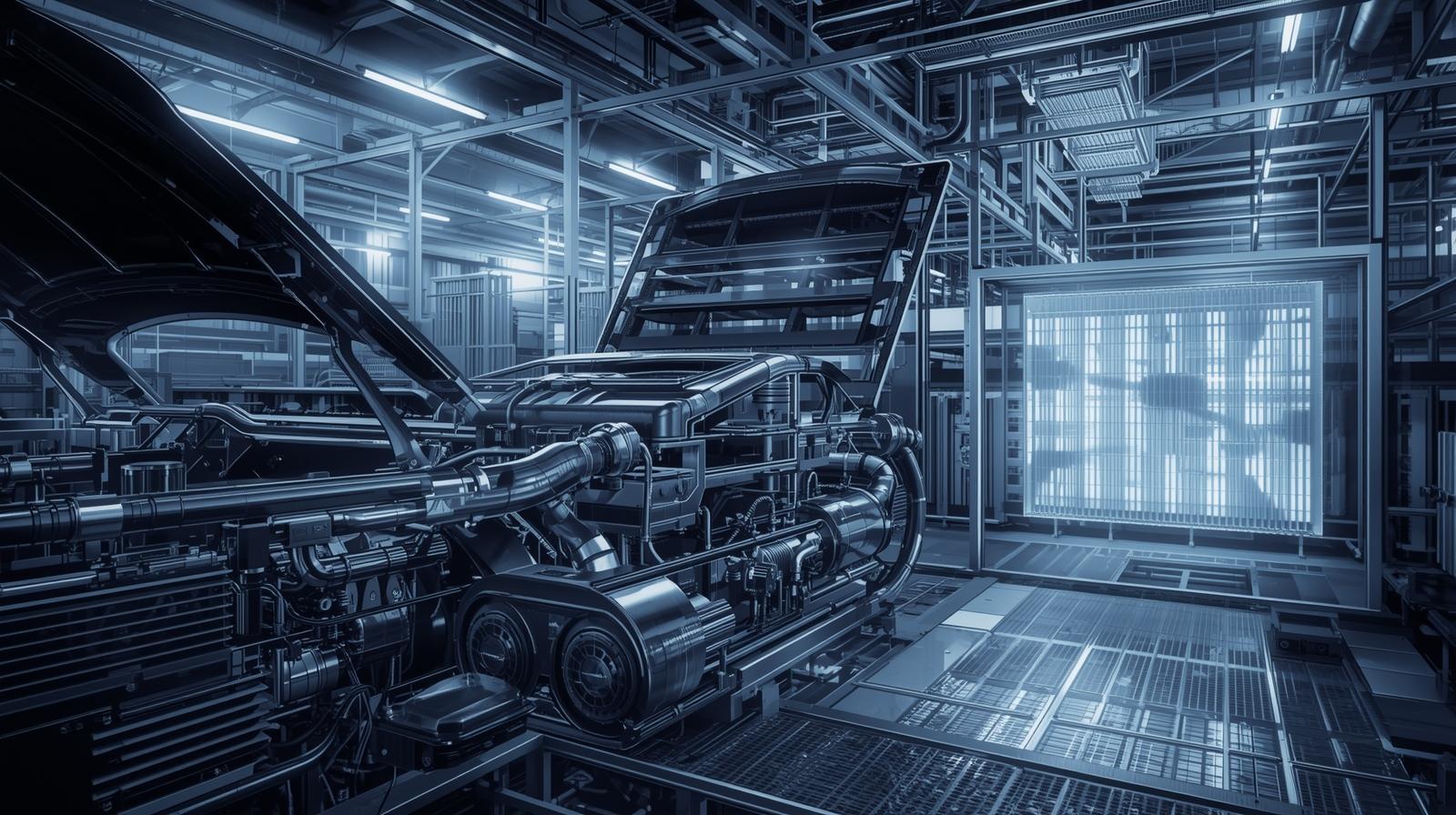HVAC systems for automotive industry play a crucial role in ensuring passenger comfort and safety within vehicles. These systems manage heating, ventilation, and air conditioning to create an optimal interior environment regardless of external weather conditions. In the automotive sector, they integrate advanced technologies to improve energy efficiency and reduce emissions. Manufacturers focus on designing these systems to meet stringent regulatory standards while enhancing user experience. The evolution of HVAC systems reflects broader industry shifts toward sustainability and innovation. Understanding their functionality helps appreciate how they contribute to overall vehicle performance.

Key Components of Automotive HVAC Systems
The compressor serves as the heart of HVAC systems for automotive industry, pressurizing refrigerant to facilitate cooling. Evaporators and condensers work together to exchange heat, enabling temperature control. Blowers and fans distribute conditioned air throughout the cabin via ducts and vents. Heaters, often integrated with the engine’s cooling system, provide warmth using coolant circulation. Control modules and sensors automate operations, ensuring precision and user convenience. Filters maintain air purity by trapping dust and allergens.
Types of HVAC Systems Used in Automobiles
Manual HVAC systems allow drivers to adjust settings directly through knobs and switches for basic control. Automatic climate control systems use sensors to maintain preset temperatures without constant input. Dual-zone systems enable separate temperature settings for driver and passenger sides. Multi-zone variants extend this to rear passengers, enhancing comfort in larger vehicles. Hybrid and electric vehicle HVAC systems incorporate heat pumps for energy efficiency. Each type caters to different vehicle segments, from economy cars to luxury models.
Importance of HVAC in Vehicle Comfort and Safety
HVAC systems for automotive industry significantly impact driver alertness by maintaining comfortable temperatures that prevent fatigue. Proper ventilation reduces humidity, minimizing window fogging for better visibility. Air filtration protects occupants from external pollutants, promoting health during long drives. In extreme weather, these systems ensure survival by regulating cabin conditions effectively. They also integrate with safety features like defrosters to clear windshields quickly. Overall, they enhance the driving experience by creating a controlled microclimate.
Evolution of HVAC Technology in the Automotive Sector
Early HVAC systems for automotive industry were rudimentary, relying on basic heaters and manual vents. The introduction of air conditioning in the mid-20th century revolutionized vehicle comfort. Electronic controls emerged in the 1980s, allowing for more precise adjustments. Modern systems incorporate smart sensors and IoT connectivity for remote operation. Sustainability drives the shift to eco-friendly refrigerants with lower global warming potential. This progression mirrors the industry’s push toward electrification and autonomy.
The global HVAC System Market size was estimated at USD 289.99 billion in 2024 and is predicted to increase from USD 299.28 billion in 2025 to approximately USD 407.77 billion in 2030, expanding at a CAGR of 6.4% from 2025 to 2030.
Download PDF Brochure @ https://www.marketsandmarkets.com/pdfdownloadNew.asp?id=202111288
Role of Refrigerants in Automotive HVAC
Refrigerants are vital fluids in HVAC systems for automotive industry, absorbing and releasing heat to cool the cabin. Traditional options like R-134a have been phased out due to environmental concerns. Newer alternatives, such as R-1234yf, offer lower greenhouse gas emissions while maintaining efficiency. Proper refrigerant management prevents leaks that could harm the ozone layer. Automotive manufacturers collaborate with suppliers to ensure compliance with international regulations. Advances in refrigerant technology continue to improve system performance and sustainability.
Integration with Vehicle Electronics and Controls
HVAC systems for automotive industry seamlessly connect with a vehicle’s electronic control unit for synchronized operation. Touchscreen interfaces allow intuitive adjustments via infotainment systems. Voice commands enable hands-free control, enhancing safety. Integration with navigation predicts climate needs based on route and weather data. Diagnostic sensors detect issues early, reducing downtime. This electronic synergy elevates user interaction and system reliability.
Energy Efficiency in Automotive HVAC Designs
Designing HVAC systems for automotive industry with energy efficiency in mind reduces fuel consumption in traditional vehicles. Variable speed compressors adjust output to match demand, saving power. Insulation in ducts minimizes heat loss, optimizing performance. In electric vehicles, efficient HVAC preserves battery range for longer trips. Regenerative heating captures waste energy from brakes or engines. These strategies align with global efforts to lower carbon footprints in transportation.
Challenges Faced by HVAC Systems in Harsh Environments
HVAC systems for automotive industry must withstand extreme temperatures, from arctic colds to desert heats. Dust and debris in off-road conditions can clog filters, reducing efficiency. High humidity levels challenge dehumidification capabilities, leading to mold growth. Vibrations from rough terrains stress components, risking failures. Rapid temperature fluctuations test system responsiveness. Engineers address these through robust materials and adaptive designs.
Maintenance Tips for Optimal HVAC Performance
Regular inspections of HVAC systems for automotive industry prevent costly repairs and ensure longevity. Replacing cabin air filters every 12,000 miles maintains air quality. Checking refrigerant levels annually avoids cooling inefficiencies. Cleaning evaporator coils removes buildup that impedes airflow. Professional servicing detects leaks early, protecting the environment. Simple habits like parking in shade reduce system strain during hot days.

Common HVAC Components and Their Functions
- Compressors pressurize refrigerant to initiate the cooling cycle in HVAC systems for automotive industry.
- Evaporators absorb heat from cabin air, providing the cooling effect.
- Condensers release absorbed heat to the outside environment.
- Expansion valves regulate refrigerant flow for precise temperature control. Blowers distribute conditioned air evenly throughout the vehicle interior.
- Heater cores use engine coolant to warm the cabin efficiently.
Impact of HVAC on Electric and Hybrid Vehicles
In electric vehicles, HVAC systems for automotive industry draw power from batteries, affecting overall range. Heat pumps offer efficient heating without resistive elements, conserving energy. Pre-conditioning features warm or cool the cabin while charging, preserving driving range. Integration with regenerative systems recaptures energy during operation. Hybrid models balance engine and electric power for HVAC demands. These adaptations support the shift to greener mobility.
Regulatory Standards Governing Automotive HVAC
Global regulations mandate low-emission refrigerants in HVAC systems for automotive industry to combat climate change. Safety standards ensure systems do not impair visibility or driver focus. Efficiency ratings guide manufacturers toward sustainable designs. Compliance testing verifies performance under various conditions. Penalties for non-compliance encourage innovation in eco-friendly technologies. These standards harmonize industry practices worldwide.
Innovations in Smart HVAC Controls
Smart HVAC systems for automotive industry use AI to learn user preferences and adjust automatically. Connectivity with smartphones allows remote climate control before entering the vehicle. Predictive algorithms anticipate needs based on weather forecasts. Gesture controls add a layer of interactivity in luxury models. Over-the-air updates improve functionality without hardware changes. These innovations enhance convenience and personalization.
Benefits of Advanced HVAC Technologies
- Enhanced energy efficiency reduces operational costs in HVAC systems for automotive industry.
- Improved air quality promotes occupant health and well-being.
- Customizable zones cater to individual comfort preferences.
- Integration with autonomous features supports hands-free driving.
- Sustainable materials lower environmental impact.
- Noise reduction creates a quieter cabin experience.
Sustainability Aspects of HVAC in Automobiles
Sustainable HVAC systems for automotive industry incorporate recyclable materials in construction. Low-GWP refrigerants minimize ozone depletion and global warming. Energy-efficient designs align with electric vehicle adoption. Lifecycle assessments guide eco-friendly manufacturing processes. Partnerships with suppliers focus on green innovations. These efforts contribute to the automotive industry’s net-zero goals.
Case Studies of Leading Automotive HVAC Implementations
Luxury brands like Mercedes-Benz integrate multi-zone HVAC systems for automotive industry with massage seats for ultimate comfort. Tesla’s heat pump technology exemplifies efficiency in electric models. Ford’s systems emphasize durability for trucks in rugged use. BMW uses AI-driven controls for predictive climate management. Toyota hybrids balance HVAC with fuel economy seamlessly. These examples showcase diverse applications across segments.
Future Trends in Automotive HVAC Development
Emerging trends in HVAC systems for automotive industry include nanotechnology for faster heat exchange. Biometric sensors will adjust settings based on occupant physiology. Augmented reality interfaces may visualize airflows. Integration with vehicle-to-everything communication enhances adaptability. Focus on antimicrobial surfaces will improve hygiene post-pandemic. These advancements promise smarter, healthier cabins.
Cost Considerations for HVAC Upgrades and Replacements
Upgrading HVAC systems for automotive industry involves balancing initial costs with long-term savings. Aftermarket options offer affordability for older vehicles. OEM parts ensure compatibility but at higher prices. Labor costs vary by complexity of installation. Energy savings from efficient systems offset expenses over time. Warranties provide peace of mind for investments.
Training and Skills for HVAC Technicians in Automotive
Technicians specializing in HVAC systems for automotive industry require knowledge of electronics and mechanics. Certification programs cover refrigerant handling safely. Hands-on training simulates real-world diagnostics. Continuous education keeps pace with technological advances. Soft skills like customer communication enhance service quality. These competencies ensure reliable maintenance and repairs.
Comparing HVAC Systems Across Vehicle Classes
Economy cars feature basic HVAC systems for automotive industry focused on essential functions. Mid-range models add automatic controls for convenience. Luxury vehicles boast advanced multi-zone capabilities. SUVs prioritize rear ventilation for families. Sports cars emphasize lightweight designs without compromising performance. Commercial vehicles require robust systems for heavy-duty use.
The Role of Simulation in HVAC Design
Simulation software aids in designing HVAC systems for automotive industry by modeling airflow dynamics. Virtual testing reduces physical prototypes, saving costs. Engineers optimize layouts for even temperature distribution. Predictive analytics forecast performance in various scenarios. Collaboration tools integrate feedback from multiple teams. This digital approach accelerates innovation cycles.
Addressing Noise and Vibration in HVAC Operations
Reducing noise in HVAC systems for automotive industry involves insulated blowers and ducts. Vibration dampers minimize disturbances from compressors. Aerodynamic designs smooth airflow, cutting turbulence sounds. Active noise cancellation technologies counteract unwanted sounds. Regular maintenance prevents wear that amplifies issues. These measures ensure a serene driving environment.
HVAC Systems and Autonomous Vehicle Integration
In autonomous vehicles, HVAC systems for automotive industry adapt to passenger-only scenarios without driver input. AI optimizes energy use based on occupancy detection. Seamless integration with other systems supports fully automated comfort. Remote monitoring allows fleet managers to oversee multiple units. Enhanced sensors provide real-time data for adjustments. This synergy advances self-driving technology.
Global Market Overview for Automotive HVAC
The market for HVAC systems for automotive industry grows with rising vehicle production worldwide. Asia-Pacific leads due to manufacturing hubs like China and India. North America focuses on innovation and electrification. Europe emphasizes regulatory compliance and sustainability. Emerging markets demand affordable, efficient solutions. Forecasts predict steady expansion driven by EV adoption.
HVAC Systems for Automotive Industry
HVAC systems for automotive industry remain essential for modern mobility, blending comfort with technology. Their evolution reflects broader industry trends toward efficiency and sustainability. As vehicles become smarter, these systems will play a pivotal role in user satisfaction. Investing in quality HVAC enhances vehicle value and longevity. Looking ahead, continued innovation promises even greater advancements in this field.
Explore In-Depth Semiconductor & Electronics Market Research:
https://www.marketsandmarkets.com/semiconductorand-electonics-market-research-87.html
FAQs
What are the main components of HVAC systems for automotive industry?
The primary components include compressors, evaporators, condensers, blowers, and control modules that work together to regulate cabin climate.
How do HVAC systems impact fuel efficiency in vehicles?
Efficient HVAC designs minimize energy draw, reducing fuel consumption in traditional cars and preserving battery life in electric models.
What advancements are expected in automotive HVAC technology?
Future trends include AI integration, biometric adjustments, and eco-friendly refrigerants for smarter, more sustainable systems.
Why is regular maintenance important for automotive HVAC?
Maintenance prevents breakdowns, ensures optimal performance, and maintains air quality for passenger health and safety.
How do HVAC systems differ in electric versus gasoline vehicles?
Electric vehicle HVAC often uses heat pumps for efficiency, while gasoline models leverage engine heat for warming the cabin.
See The Latest Semiconductor Reports:
Solid State Relay Market Size, Share & Trends : https://www.marketsandmarkets.com/Market-Reports/solid-state-relay-market-260413598.html
Battery Technology Market Size, Share & Trends : https://www.marketsandmarkets.com/Market-Reports/battery-technology-market-253343109.html
Radiation Hardened Electronics Market Size, Share & Trends : https://www.marketsandmarkets.com/Market-Reports/radiation-hardened-electronics-market-44047967.html
Smart Appliances Market Size, Share & Trends : https://www.marketsandmarkets.com/Market-Reports/smart-appliances-market-8228252.html
Quantum Computing Market Size, Share & Trends : https://www.marketsandmarkets.com/Market-Reports/quantum-computing-market-144888301.html
Cold Chain Monitoring Market Size, Share & Trends : https://www.marketsandmarkets.com/Market-Reports/cold-chain-monitoring-market-161738480.html
